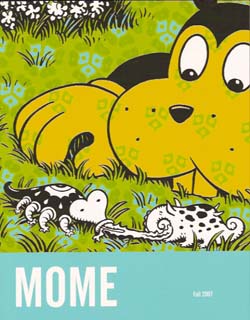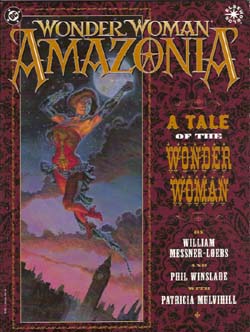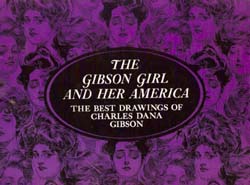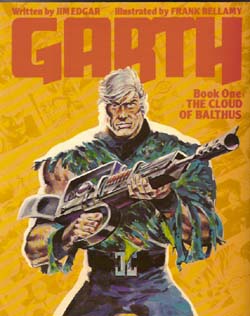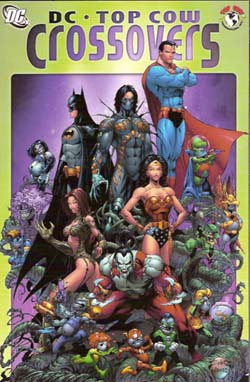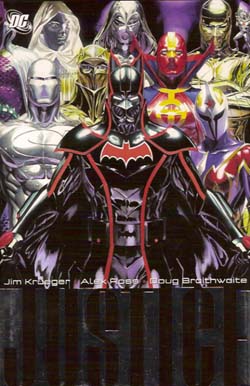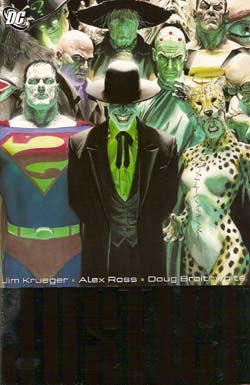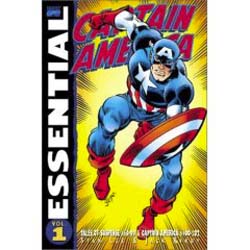
By Stan Lee, Jack Kirby, & various (Marvel)
ISBN 0-7851-0740-1
During the Marvel Renaissance of the early 1960’s Stan Lee and Jack Kirby tried the same tactic that had worked so tellingly for DC Comics, but with mixed results. Julie Schwartz had incredible success with his revised versions of the company’s Golden Age greats, so it seemed natural to try and revive the characters that had dominated Timely/Atlas in those halcyon days. A new Human Torch had premiered as part of the revolutionary Fantastic Four, and in the fourth issue of that title the Sub-Mariner resurfaced after a twenty year amnesiac hiatus (everyone concerned had apparently forgotten the first abortive attempt to revive their superhero line in the mid 1950s).
The Torch was promptly given his own solo feature in Strange Tales from issue #101 (see Essential Human Torch vol.1, ISBN 0-7851-1309-6) and in #114 the flaming teen fought an acrobat pretending to be Captain America. The real thing promptly surfaced in Avengers #4 and after a captivating and centre-stage hogging run in that title was granted his own series as half of the “split-book†Tales of Suspense with #59 (cover-dated November 1964).
That initial outing ‘Captain America’, scripted by Stan Lee and illustrated by the staggeringly perfect team of Jack Kirby and Chic Stone is a simple fight tale as an army of thugs invades Avengers Mansion since only the one without superpowers is at home, and the next issue held more of the same, when ‘The Army of Assassins Strikes!’. ‘The Strength of the Sumo!’ was insufficient when Cap invaded Viet Nam to rescue a lost US airman and Cap took on an entire prison to thwart a ‘Break-out in Cell Block 10!’
After these gloriously simplistic romps the series took an abrupt turn and began telling tales set in World War II. ‘The Origin of Captain America’, by Lee, Kirby and Frank Ray (AKA Giacoia) recounted how physical wreck Steve Rogers was selected to be the guinea pig for a new super-soldier serum only to have the scientist responsible die in his arms, cut down by a Nazi bullet.
Now forever unique he was given the task of becoming a fighting symbol and guardian of America, based as a regular soldier in a boot camp. It was there he was unmasked by Camp Mascot Bucky Barnes, who blackmailed the hero into making the boy his sidekick. The next issue (Tales of Suspense #64) kicked off a string of spectacular thrillers as the heroes defeated the spies Sando and Omar in ‘Among Us, Wreckers Dwell!’ and Chic Stone returned – as did Cap’s greatest foe – for the next tale ‘The Red Skull Strikes!’
‘The Fantastic Origin of the Red Skull!’ saw the series swing into high gear as sub-plots and characterisation were added to the all-out action and spectacle. ‘Lest Tyranny Triumph!’ and ‘The Sentinel and the Spy!’ (both inked by Giacoia) combined espionage and mad science in a plot to murder Winston Churchill, and the heroic duo stayed in England for ‘Midnight in Greymoor Castle!’ (with art by Dick Ayers over Kirby’s layouts – which are very rough pencils that break down the story elements on a page) and the second part ‘If This be Treason!’ had Golden Age and Buck Rogers artist George Tuska perform the same function. The final part (and the last wartime adventure) was ‘When You Lie Down with Dogs…!’ which added Joe Sinnott inks to the mix for a rousing conclusion to this frantic tale of traitors, madmen and terror weapons.
It was back to the present for Tales of Suspense #72 and Lee, Kirby and Tuska revealed that Cap had been telling war stories to his fellow Avengers for the last nine months. ‘The Sleeper Shall Awake!’ began a classic adventure as a Nazi super-robot activates twenty years after Germany’s defeat to exact a world-shattering vengeance. Continuing in ‘Where Walks the Sleeper!’ and concluding in ‘The Final Sleep!’ this masterpiece of tension and suspense perfectly demonstrated the indomitable nature of this perfect American hero.
Dick Ayers returned with John Tartaglione inking ‘30 Minutes to Live!’ which introduced both the Batroc the Leaper and a mysterious girl who would eventually become Cap’s long-term girl-friend, S.H.I.E.L.D. agent Sharon Carter, in a taut 2-part countdown to disaster ending with ‘The Gladiator, The Girl and the Glory’, illustrated by John Romita (Senior). This was the first tale which had no artistic input from Jack Kirby, but he laid out the next issue (TOS #77) for Romita and Giacoia. ‘If a Hostage Should Die!’ again returned to WWII and hinted a both a lost romance and a tragedy to come.
‘Them!’ returned Kirby to full pencils and Giacoia to the regular ink spot as Cap teamed with Nick Fury in the first of the Star-Spangled Avenger’s many adventures as a (more-or-less) Agent of S.H.I.E.L.D. It was followed by ‘The Red Skull Lives!’ as his arch nemesis returned from the grave to menace the Free World again. He was initially aided by the subversive technology group AIM, but stole their ultimate weapon in ‘He Who Holds the Cosmic Cube!’ (inked by Don Heck) and ‘The Red Skull Supreme!’
‘The Maddening Mystery of the Inconceivable Adaptoid!’ pitted Cap against AIM’s artificial life-form, capable of becoming an exact duplicate of its victim in a tale of psychological warfare. ‘Enter… The Tumbler!’ (inked by Ayers) and ‘The Super-Adaptoid!’ completed an epic of breathtaking action that further cemented the links between the various Marvel comics, building a shared continuity would carry the company to market dominance in a few short years.
‘The Blitzkrieg of Batroc!’ and ‘The Secret!’ returned to the earliest all-action, overwhelming odds yarns and ‘Wanted: Captain America’ (by Roy Thomas, Jack Sparling and Joe Sinnott) was a lacklustre interval involving a frame-up before Gil Kane had his first run on the character with ‘If Bucky Lives…!’, ‘Back From the Dead!’, ‘…And Men Shall Call Him Traitor!’ and ‘The Last Defeat!’ (TOS #88-91, these last two inked by Sinnott) in a superb drama of blackmail and betrayal starring the Red Skull.
Kirby and Sinnott were back for ‘Before My Eyes Nick Fury Died!’, ‘Into the Jaws of… Aim!’ and ‘If This Be… Modok!’ as the hero fought a giant brain-being manufactured purely for killing. ‘A Time to Die… A Time to Live’ and ‘To Be Reborn!’ has the hero retire and reveal his secret identity, only to jump straight back into the saddle with S.H.I.E.L.D. for #97’s ‘And So It Begins…’ a four part tale that finished in issue #100, with which number Tales of Suspense became simply Captain America. Guest starring the Black Panther, it told of the return of long-dead Baron Zemo and an orbiting Death Ray.
‘The Claws of the Panther!’ was inked by both Sinnott and the great Syd Shores, who became the regular inker with ‘The Man Who Lived Twice!’, whilst that premier hundredth issue (how weird is that?) used the extra page length to retell the origin before concluding a superb thriller with ‘This Monster Unmasked!’
Captain America #101-102 saw the return of the Red Skull and another awesome Nazi revenge weapon in ‘When Wakes The Sleeper!’ and ‘The Sleeper Strikes!’.
This volume concludes with an extra adventure from his actual war career. ‘Captain America and the Terror That Was Devil’s Island’ is from Captain America Comics #10, 1941, written by Stan Lee and illustrated by Joe Simon.
These are tales of dauntless courage and unmatchable adventure, fast paced and superbly illustrated, which rightly returned Captain America to the heights that his Golden Age compatriots the Human Torch and the Sub-Mariner never regained. They are pure escapist magic. Great, great stuff for the eternally young at heart.
© 1941, 1964, 1965, 1966, 1967, 1968, 2000, 2007 Marvel Characters, Inc. All Rights Reserved.
